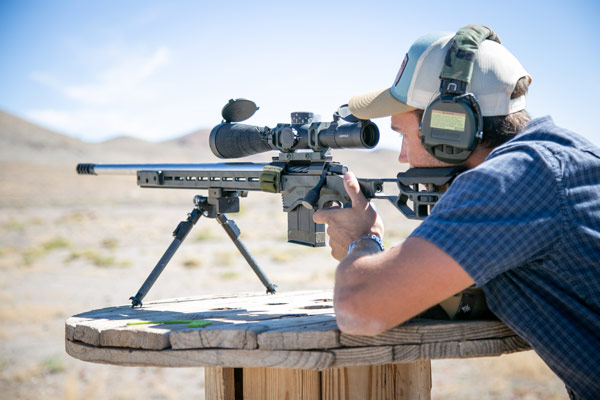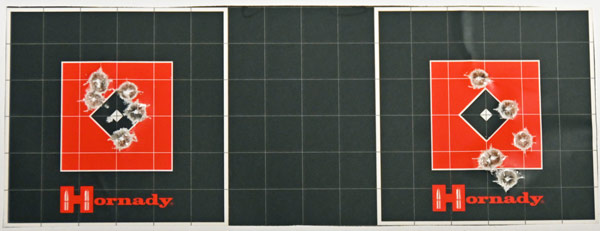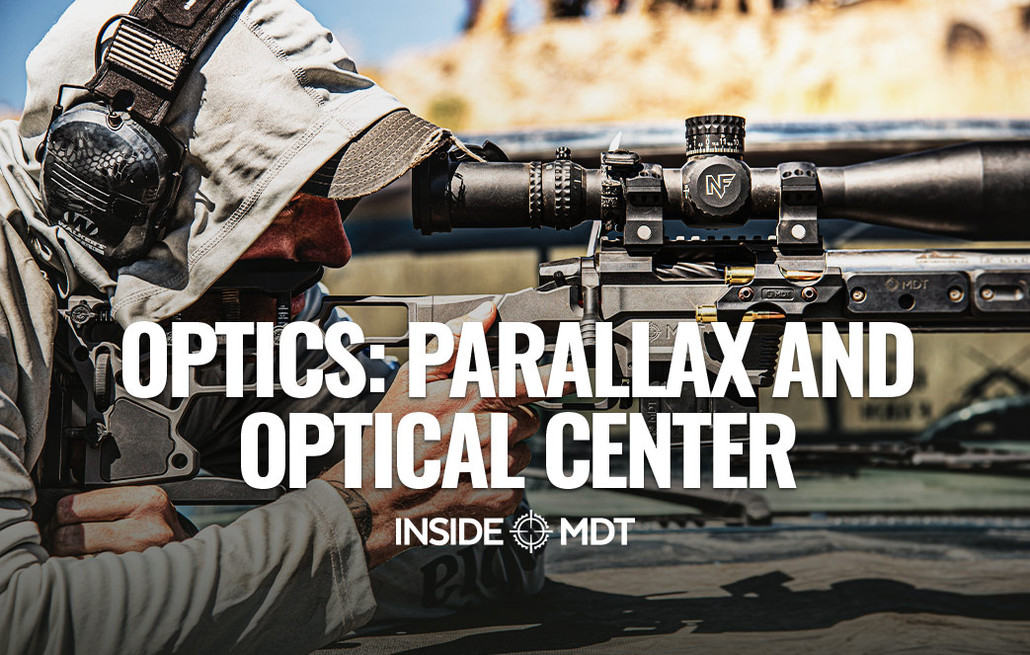Posted by Al Voth on 2023 Jun 29th
Optics: Parallax And Optical Center - Inside MDT
Parallax is one of those optical terms that can be confusing until a person sits down and does their own testing to demonstrate its existence. Simply put, it refers to the difference in the apparent position a rifle scope's reticle occupies on a target based on the location of the shooter's eye. It's best observed by placing a scoped rifle on a set of sandbags and looking at a target through the scope without touching the rifle. As the eye is moved back and forth within the scope's field of view, the reticle will appear to change position. This happens because the reticle is not in the same focal plane as the target.
More: Optics: Understanding The Optical Triangle
A manufacturer can only set one point at which there is no parallax (on a fixed parallax scope, it's often around 100 yards); any other distance will show some parallax. But some scopes have adjustments to correct for parallax at any distance beyond a certain minimum. This adjustment will be found on the objective lens or as a dial mounted on the left side of the scope's main tube. However, these adjustments can make a scope larger, heavier, and more expensive.

When looking through a rifle scope with the eye properly centered, the shooter will see a full circle with clearly defined edges. When the eye is out of the scope's optical center, a crescent-shaped shadow (right) creeps into view.
Traditional wisdom says that parallax adjustment isn't needed because of the target size involved in big game hunting. However, adjusting parallax is important for competitive target shooting, long-range shooting, or varmint hunting, where the ranges can be long and the targets small. I've generally subscribed to those ideas, and the scopes on my rifles reflect it. However, I decided to test those concepts to see their validity.

To do so, I took two rifles with representative scopes to the shooting range. The first was equipped with a simple Leupold 3-9X scope and fixed parallax. The second wore a Zeiss scope that had a parallax adjustment on the left side of the main tube. The plan was to shoot these rifles at 100 yards to see how much parallax error affected group size. The first scope, of course, has no parallax adjustment, but the second scope has excellent adjustments, and I'd do my best to dial out any visible parallax.
The first six-shot group from each rifle would be shot with my eye as perfectly centered in the scope's field of view as I could manage. The second group would be shot with my eye deliberately misplaced. I'd fire three shots with my eye jammed as far to the right as possible but still able to center the reticle on target, and then three shots with my eye pushed to the left. Would there be a difference in group size, and if so, how much? The attached table shows the results of my testing.
All groups are six shots at 100 yards.
As you can see, the groups shot with the fixed parallax scope tripled in size when the eye was off-center. This indicates the importance of keeping the eye centered when trying to make an accurate shot with a fixed parallax scope. No surprises there.

The surprising results of shooting a parallax-adjustable scope with the eye centered (left) and then with the eye deliberately misplaced (right).
But look at the results for the adjustable parallax scope. Even though the parallax was carefully dialed out, the group size still grew significantly when the eye was misplaced behind the scope. At first, this surprised me, but once I started to think about it a little more, I realized it did make sense. After all, every scope has an optical center that is engineered to be the "sweet spot" for that optical instrument. In that center zone, there is minimum distortion, and objects appear at their maximum clarity. Move the eye out of that zone, as I did deliberately, and even though parallax may be gone, there will still apparently be an effect on group size.
An interesting observation was both groups shot with the eye off center showed a lot of vertical dispersion when I was expecting only horizontal spread. I'll have to do more shooting to see if that happens consistently, and if it does, talk to an optical engineer to explain it.
This brings us to what is the most valuable lesson to be learned from this little exercise. The shooter's eye must be in the center of the scope's view for maximum accuracy, even if the rifle scope has adjustable parallax. Move the eye outside of that sweet spot, and bad things can happen, whether you shoot an adjustable parallax scope or not. This is an easy test to do; consider giving it a try on your next range visit and see what your results are.
OPTICS RESOURCES FROM MDT
- How To Test Your New Riflescope
- Red Dot Sights on Precision Rifles
- Optics: Understanding The Optical Triangle
- Rangefinders: Testing Beam Divergence And Reticle Alignment
- Shooting And Eye Health - Inside MDT
- Scope Levels: Take your shooting to the next LEVEL
ABOUT THE AUTHOR
Al Voth calls himself a "student of the gun." Retired from a 35-year career in law enforcement, including nine years on an Emergency Response Team, he now works as an editor, freelance writer, and photographer, in addition to keeping active as a consultant in the field he most recently left behind—forensic firearm examination. He is a court-qualified expert in that forensic discipline, having worked in that capacity in three countries. These days, when he's not working, you'll likely find him hunting varmints and predators (the 4-legged variety).


 EUR
EUR
 Canadian Dollars
Canadian Dollars
